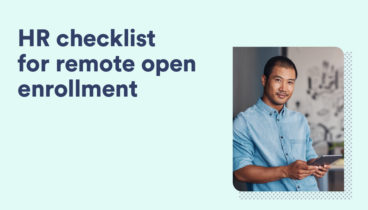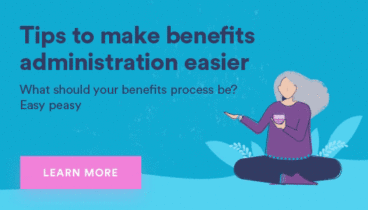The fastest, simplest way for employees to make benefits selections is through using online tools. Keep these 5 things in mind when conducting remote open enrollment.

Whether you have an onsite, fully remote, or hybrid workforce, you may opt to do open enrollment (OE) remotely — mainly because it’s the easiest way. Indeed, the fastest and simplest way for employees to make benefits selections is via remote (or online) tools.
Despite these benefits, remote open enrollment is a multifaceted initiative that requires attention to detail. With so much to do, it’s easy to miss critical steps.
Below are 5 things to keep top of mind when conducting open enrollment remotely.
1. Open enrollment dates
Open enrollment is the period of time when employees can elect or change their employer-sponsored options for medical, dental, and vision insurance; flexible spending accounts; life insurance; and other applicable benefits. It is also the period of time when someone who does not have job-based insurance can enroll in individual coverage via the Affordable Care Act (ACA) federal or state marketplace.
Both employer-based and ACA-based open enrollment are driven by deadlines. Therefore, it’s vital that you stay on top of these dates, which include:
- When open enrollment starts and ends at your company.
- When open enrollment starts and ends on the ACA federal and state marketplaces
- What constitutes a “special enrollment period” (e.g., 30 days after the qualifying event) at your company and on the ACA marketplace
Inform your employees of these dates well in advance of open enrollment, so they will have time to prepare.
2. Virtual communication channels
Performing open enrollment remotely is about reaching your employees wherever they are. Typically, this means leveraging multiple virtual communication methods. The appropriate channels will depend on the type of benefits information, your employees’ communication preferences, and what’s most feasible for your business.
Before open enrollment starts, evaluate your virtual communication channels, which may include a combination of the following:
- Website
- Text messaging
- Video
- Chatbots
- Social media
- Mobile apps
- Digital benefit guides
- Digital postcards, flyers, and brochures
- Online benefit fairs
- Interactive decision-support tools
- Digital Q&As
Before you post benefits information online, make sure the information is not confidential and that you’re legally allowed to post it online. Also, consider tracking virtual communications engagement.
Before you post benefits information online, make sure the information is not confidential and that you’re legally allowed to post it online. Also, consider tracking virtual communications engagement — such as email open rates and website page views. Depending on the results, you may need to boost engagement by adjusting your virtual communication methods.
Note that you can enhance engagement via HR software, which offers a centralized platform for managing benefits, open enrollment, and virtual communications.
3. Open enrollment goals
When establishing remote open enrollment goals, consider the following:
- The type of benefits you currently offer
- How many employees are eligible for benefits
- How you and your employees feel about your current benefits structure
- How you and your employees feel about your current carrier and their provider network
- Whether your remote employees have sufficient coverage, based on where they live
- Whether any of your remote employees recently moved to a new state (which might impact their medical insurance benefits, rates, and access)
- Whether your benefits are tailored to match the needs of your remote or hybrid workforce
- Whether your company underwent a major change, such as company name change, merger, or opening new offices in different states
- Whether foreseeable business changes could impact your financial position and how you allocate benefits
- Whether any employees are likely to terminate, and if so, how their benefits will be affected
Depending on the results, you may need to make adjustments for the upcoming open enrollment season. For example, you may need to:
- Add more telehealth services to improve healthcare access for remote employees
- Implement remote and onsite-friendly benefits for your hybrid team
- Eliminate underutilized benefits
- Determine federal or state Consolidated Omnibus Budget Reconciliation Act (COBRA) requirements
In addition, benchmark data to see what companies like yours are offering in terms of benefits. This will help you design competitive benefits packages for open enrollment.
4. Broker participation
Reviewing benefits, comparing costs, and distributing benefits information to employees can be time consuming and complex. It’s best to work with a benefits broker who can promptly get you the information you need to make informed decisions.
It’s best to work with a benefits broker who can promptly get you the information you need to make informed decisions.
Work with your broker to:
- Review your current healthcare plans and pricing, including cost-sharing amounts.
- Examine quotes from current and alternative insurance carriers.
- Assess additional benefits or perks that you may want to offer — such as wellness programs, commuter benefits, FSA, etc.
- Identify anticipated employee usage for benefits or perks.
- Determine the most suitable renewal packages based on your needs and budget.
- Ensure healthcare plan options meet ACA (and other federal) requirements and are compliant with state and local laws.
- Finalize your benefits offerings and costs.
- Provide open enrollment education and materials to employees — such as plan summaries, open enrollment booklets, and Q&As.
Your broker can help you develop open enrollment goals that align with your business objectives. Moreover, they can provide you with best practices for navigating open enrollment remotely.
5. Open enrollment preparation
As open enrollment gets closer, make sure you’re well prepared. For example:
- Verify open enrollment dates and deadlines.
- Test the efficacy of your virtual communication channels.
- Tell employees that open enrollment is approaching, and give them the deadlines.
- Let employees know whom to contact if they have benefits questions or need additional information, during and after open enrollment.
- Confirm changes to your benefits programs and plan documents.
- Review and approve benefits costs.
- Collaborate with your broker to distribute benefits materials to employees.
- Announce new programs or perks (e.g., wellness programs, commuter benefits, etc.).
- Continue to send out open enrollment reminders, so employees don’t forget.
It’s important to have a checklist for administering open enrollment remotely from start to finish. Ideally, the checklist should include timelines, starting several months prior to open enrollment (such as 90 days out) and ending when coverage begins. Consider creating a separate checklist with timelines for your employees, as well.
For examples of OE checklists for employers and employees, see Open Enrollment 2022: Prepare With These Timelines and Important Dates. You can modify the information to fit your unique business needs and any remote requirements.







